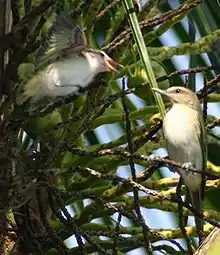Black-whiskered vireo
The black-whiskered vireo (Vireo altiloquus) is a small passerine bird, which breeds in southern Florida, USA, and the West Indies as far south as the offshore islands of Venezuela. It is a partial migrant, with northern birds wintering from the Greater Antilles to northern South America. This species has occurred as a rare vagrant to Costa Rica.
| Black-whiskered vireo | |
|---|---|
 | |
| Scientific classification | |
| Kingdom: | Animalia |
| Phylum: | Chordata |
| Class: | Aves |
| Order: | Passeriformes |
| Family: | Vireonidae |
| Genus: | Vireo |
| Species: | V. altiloquus |
| Binomial name | |
| Vireo altiloquus (Vieillot, 1808) | |
 | |
Habitat
The breeding habitat is open deciduous wooded areas and cultivation, and in Florida also mangroves. The black-whiskered vireo builds a cup nest in a fork of a tree branch, and lays 2-3 white eggs.
Description
This vireo is 14–15 cm in length, has a 25 cm wingspan and weighs 17–19 g. It has thick blue-grey legs and a stout bill.
The adult black-whiskered vireo has dull olive-green upperparts and white underparts, with yellowish on the flanks and under the tail. It has red eyes and a grey-brown crown with faint dusky edges. There is a dark line through the eyes and a white eyebrow stripe. There is a distinctive black line (the "whisker") on the neck sides. Juvenile birds are similar, but have brown-red eyes.
This species is similar to red-eyed vireo, but is duller and browner above, and is best distinguished by the black whisker mark. The song is a three-syllable whip, Tom Kelly, more abrupt than that of red-eyed vireo.
The Florida race V. a. barbatulus is shorter-billed by 15% than the northern Caribbean subspecies V. a. bonairensis. The latter form has occurred in the US as a vagrant to Florida and Louisiana.
Diet and behavior
The black-whiskered vireo gleans insects from tree foliage, sometimes hovering while foraging. It will also eat small quantities of berries
This bird suffers from nest parasitism by the brown-headed cowbird in its US range, and shiny cowbird further south.
References
- BirdLife International (2012). "Vireo altiloquus". IUCN Red List of Threatened Species. 2012. Retrieved 26 November 2013.CS1 maint: ref=harv (link)
